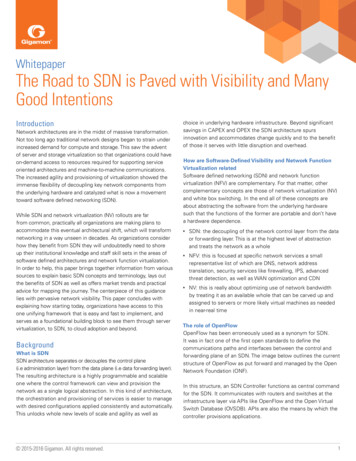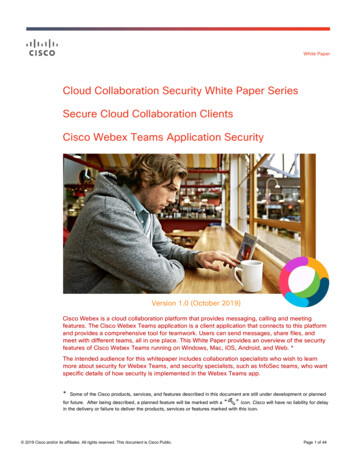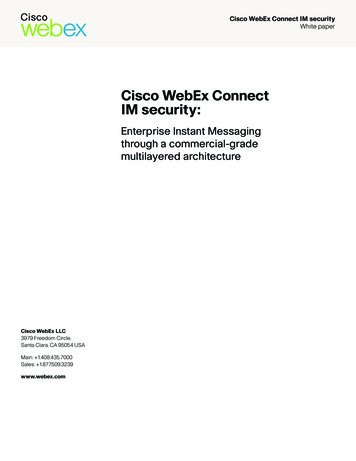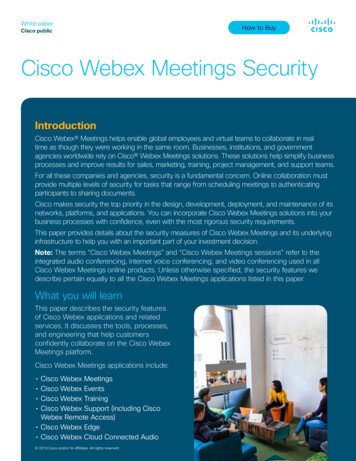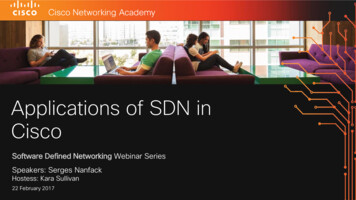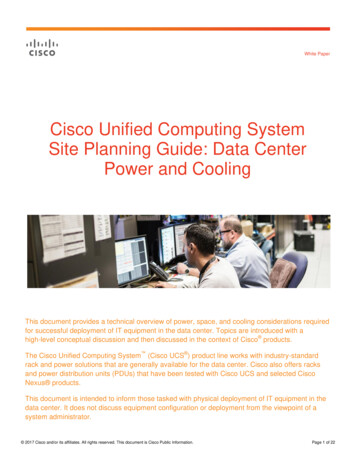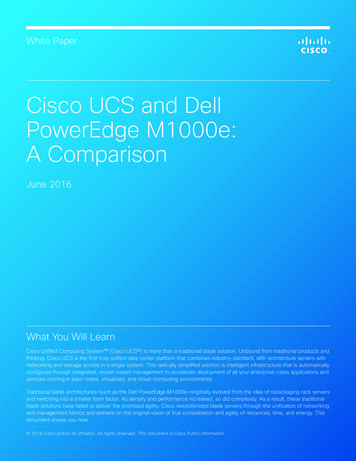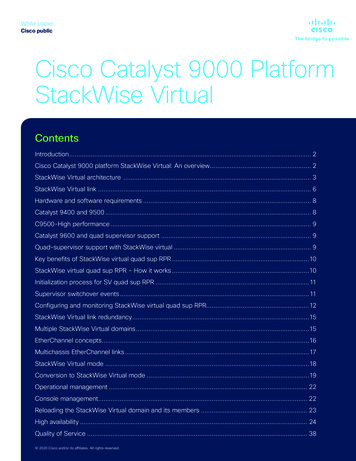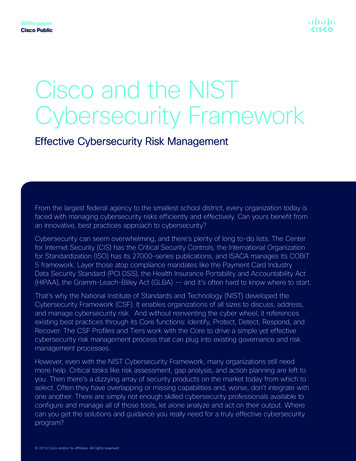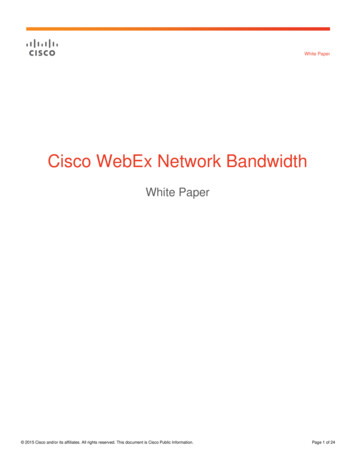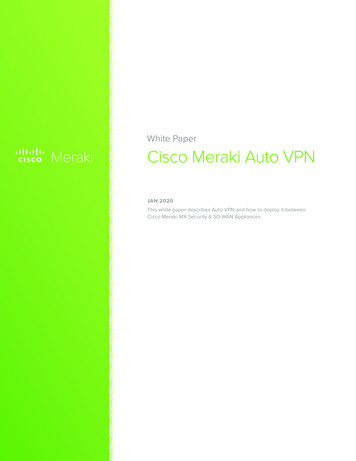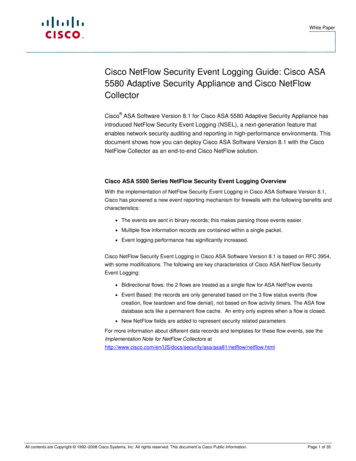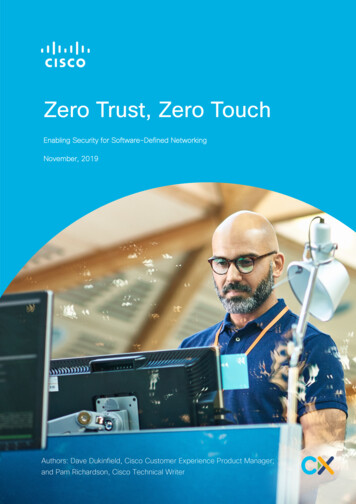
Transcription
Zero Trust, Zero TouchEnabling Security for Software-Defined NetworkingNovember, 2019Authors: Dave Dukinfield, Cisco Customer Experience Product Manager;and Pam Richardson, Cisco Technical Writer
Security, Integration, and AutomationToday, artificial intelligence, the cloud, expanding amounts of data, and increasinglycomplex cybersecurity threats are rapidly changing the technology landscape.Mobile users expect immediate, high-performance secure connectivity at all times,everywhere, and on any device. Security for these services must be integrated fromthe initial design and deployed as part of the orchestrated automation of theseservices thus ensuring the service provider’s security policies are implemented endto end.Multi-Layer Security and ProtectionReliable, high-performance networks are essential for modern businesses. Everyaspect of business is affected by network health and functionality, allowingemployees and customers to access data and applications from multiple locations,with multiple devices.Cybersecurity threats are becoming more sophisticated and dangerous across abroader attack surface—one that is no longer contained within well-definedperimeters. Figure 1 illustrates the necessity of even faster response and mediationto these increasing threats.Figure 1. Slower Response Greater RiskZero Trust, Zero Touch: Enabling Security for Software-Defined Networking2
Ensuring adequate security levels is not just a matter of deploying the righttechnology in the right place. It is critical to define proper procedures clearly, andmake sure they are adhered to continuously throughout the entire security chain—particularly at an operational level.Software-defined networking (SDN), a key to current Service Provider deployments,can simplify network control and operations by decoupling the control and dataplanes from the underlying hardware. By creating dynamic, programmable, logicalnetwork components, SDN can deliver dependable network services that are fasterand easier to design, manage, and troubleshoot. This delivery needs to incorporatevisibility into the control, data, orchestration, and management planes, raising alertsfor abnormal traffic and allowing the operator to mitigate that traffic over an existingor dedicated plane. The goal is to reduce the time scale ofthreat/detection/response from days/weeks to minutes/hours while maximizing theagility of the operator tools to respond and mitigate.Zero Trust, Zero Touch: Enabling Security for Software-Defined Networking3
Zero Trust, Zero TouchAligning to current Service Provider security policies, the SDN approach is a ZeroTrust, Zero Touch network.As a key enabler of business activity, the network must be designed andimplemented with security at its foundation supporting the key business functions.To accomplish this, a complete, holistic approach is required——one thatencompasses protecting networks, elements, services, and management, as well asdata flows leveraging analytics, automation, and orchestration (Figure 2).A defense-in-depth approach, where multiple layers of protection are established,driven by automation (see Figure 3). Security is about adoption of controls; the morecontrols that can be deployed and integrated into the network, the better ourchance of mitigating potential threats.Zero Trust, Zero Touch: Enabling Security for Software-Defined Networking4
Figure 3. Six Steps to a Zero Trust, Zero Touch Network Strong identity is established to ensure that every network element (VNF,infrastructure, automation processes, people) that accesses the network hasestablished the appropriate level of trust, including signed software andconfiguration. Configuration compliance to validate security posture for every networkelement, to ensure ongoing assurance as to status of security. Segmentation of services through security enclaves reflecting networkstructure, to secure data flows and contain potential security eventsidentified. Visibility of activities of the management plane, control plane,orchestration/automation plane and resulting VNFs, OSS/BSS, and useractivity for identification of potential anomalies. Highly restricted access to network elements contained through automatedvirtual management access layer. Strong security perimeters at the Internet and the RAN, to protect againstexternal network attacks. Attacks can come from external networks andcompromised users.Zero Trust, Zero Touch: Enabling Security for Software-Defined Networking5
Network as Security EnforcerSecurity Perimeter GatewayAside from traditional attacks against servers and caches (for example, via HTTPresponse splitting), new threat vectors arise in a mobile network. For instance,Distributed Denial of Service (DDoS) attacks can cause major disruption to thelatencies on which service level agreements are based. DDoS would cause networkoutages with attacks on control plane (e.g. DNS or Policy functions). DDoS impactthrough disruption to the network and the service latencies is not unique to 4G. With5G, peering is also distributed to the MEC (edge). Thus, DDoS capabilities need tobe also deployed at the MEC to protect packet core functions (such as UPF), whichhave been moved out to this edges.Vulnerabilities that might cause this would be through: Traditional attacks on hardware components of the infrastructure Application vulnerabilities APIs that are not properly secured Rogue nodes/elements within the architecture.The core architectures of virtualized 4G or 5G also create entirely new securitythreat vectors arising out of virtualized mobile network components (includingseparate slices being created for various services), as well as exposure of themobile network core components toward third-party applications and externalInternet-facing interfaces. The Central Data Center (CDC) DMZ zone hosts an arrayof applications and services that communicate with services in the Internet—all ofwhich must be protected.Other aspects of the threat surface are external-facing interfaces (such as BGPpeering points) and roaming interfaces that Mobile Network Operators (MNOs) usefor interconnection between operators to allow their subscribers to roam betweenthem. BGP monitoring is employed to perform route monitoring using key BGPZero Trust, Zero Touch: Enabling Security for Software-Defined Networking6
networking protocol metrics such as reachability and path changes in order todetect attacks like route hijacks or routing changes associated with DDoS mitigation(BGP flowspec). Roaming agreements are operator specific, but strong securityprocedures are needed to ensure protection on host network. Any malicious attackon the roaming partner’s network could compromise the host network.Subscriber access to a safe Internet is vital in maintaining the network’s securityposture. One way to keep this in check is to restrict access to malicious sites andapplications by controlling DNS traffic queries. All DNS traffic must be checked forconnections intended for malicious URLs.All these threats can be mitigated by applying layered security, to protect andsecure traffic to and from the Internet via the Internet-facing peering routers back tothe DMZ.A Security Perimeter Gateway offers many benefits: Security in layers (such as NGFW IPS and DDoS detection and mitigation)provides in-depth defense by containing threats detected in specificcommunication flows. Integration of security control platforms with network elements, which resultsin visibility and white-list control of known baseline communication. Access on an as-needed basis to the infrastructure for operations assuresthat windows of access are minimal at best.Secure Cloud ServicesSecure Cloud Services help make sure that an organization delivers and consumescloud services with a high degree of security. For our current Service Providersolutions, we assessed data protection policies, user behaviors, and architecture totailor a strategy that covers the following: VNF/Controller: Strong segmentation model, VNF security groups, isolation offunctions and control flows, visibility into interfaces Infrastructure: Hardening NFVi, securing E-W trafficZero Trust, Zero Touch: Enabling Security for Software-Defined Networking7
Network Services: Securing network interfaces, cloud interfaces,segmentation policy enforcement, peering and roaming interfaces Management: Securing application interfaces, cloud interfaces, segmentationpolicy enforcement, and visibility into interfaces Orchestration: Securing orchestration management and interfaces, visibilityand policy enforcement into API access.Securing the Mobile BackhaulIn our Mobile Backhaul (MBH) security design, we used the following principles toensure strong design and implementation (see Figure 4): Segmenting/securing security planes:oUser/Data Plane: Constitutes the transit data and addresses security ofaccess and customer use of the service provider’s network. This planealso represents actual end-user data flows. End users may use a networkthat provides connectivity only. They may use it for value-added servicessuch as VPNs, or they may use it to access SP network-basedapplications.oControl/Signaling and Orchestration: Protects activities that enableefficient delivery of information, services, and applications across thenetwork. It typically involves machine-to-machine communications ofinformation, which allows the machines (such as switches or routers) todetermine how best to route traffic across the underlying transportnetwork. Orchestration will be extended to the MEC and needs properMBH defense.oManagement: Protects OAM&P functions of the network elements,transmission facilities, back-office systems (such as operations supportsystems, business support systems, customer care systems), and datacenters. This plane supports the fault, capacity, administration,provisioning, and security (FCAPS) functions.Zero Trust, Zero Touch: Enabling Security for Software-Defined Networking8
Confirming identity of communicating parties. Neighboring nodes should beregarded as hostile unless trust is established. Offering ACLs for flows between authorized end-points without beingdiverted or intercepted. Providing authorized access to network resources through Multi FactorAuthentication (MFA)ControlIoT Core NetworkSubDBNetwork SliceSelection FunctionMBB Core NetworkStreaming CameraCore NetworkNetwork Platform for Slicing Spans RAN and CoreFigure 4. Securing Mobile Backhaul through Slicing and CUPS ImplementationMobile Services OverlayModern MNO architecture is considered as an underlying infrastructure fornumerous service overlays — Mobile Services being one (see Figure 5). All networkelements on the Mobile Services overlay must align with the following: Comply fully with 3GPP Standards-preferred release 15 (minimum release13), ITU - T X.805 UE to authenticate and access services via the network securely (including3GPP and non-3GPP access), particularly to protect against attacks on(radio) interfaces Allow network nodes to securely exchange both signaling (control) and userplane data Secure the user access to mobile equipmentZero Trust, Zero Touch: Enabling Security for Software-Defined Networking9
Verify that applications in the user and provider domains exchangemessages securely Ensure that the Service-Based Architecture (SBA) architecture networkfunctions communicate securely within the serving network domain, as wellas with other network domains Inform user whether a security feature is in operation.Each service that Service Provider’s automated orchestration deploys must meet orexceed these requirements to ensure security of user/applications, as well as thefour key network planes (User, Control, Orchestration, Management).Figure 5. Mobile Services OverlayZero Trust, Zero Touch: Enabling Security for Software-Defined Networking10
Zero TrustCommon Security ServicesSecurity as a Service (SaaS) gives cloud provider and managed security serviceproviders the opportunity to create subscription-based, “as a service” offers basedon Cisco Security products into a corporate infrastructure. SaaS providers can: Drive adoption of controls through automation into enterprise infrastructure Create federated Security services to support technology of enclave(mutually enhance each federation member’s security posture) Leverage common investments of exiting functionality in network for visibilityand control Inherit trust of shared service for Network solutions.VNF Security ServicesFigure 6 illustrates the VNF Security Services for a given MNO. SaaSencompasses a secure enclave around these user services. These services arebased on secure standards and deployment. Visibility services ensure that only allowed endpoints can specificallycommunicate. Prevention and detection systems capture and mitigate malicious orsuspect traffic with involvement from the Security Operations Center (SOC). Secure access based on strong identity services allow trusted engineers theability to update and troubleshoot.Zero Trust, Zero Touch: Enabling Security for Software-Defined Networking11
Figure 6. VNF Security ServicesLegend: Starts with Security Of the Network (SON), VNF, and Enclave (1) Security Services IN the network (2) requirements, placement, andcriteria determined by (1) Data feeds for SOC dependent on (3) Automation determined by (1), (2), and (3)Identity ManagementA Service Provider’s Identity Management systems (see Figure 7) giveadministrators the tools and technologies they need to change a user’s role, trackuser activities, create reports on those activities, and enforce policies on an ongoingbasis. These systems are designed to provide administering of user access acrossan entire enterprise, and to certify compliance with corporate policies andgovernment regulations. Administers can: Maintain asset management processes for all entities on the network Conduct strict management of local accounts Provide unique certificates for all entities for identification and authentication Leverage certificates for identification, verification and data flow protection.Zero Trust, Zero Touch: Enabling Security for Software-Defined Networking12
Figure 7. Identity ManagementChain of Trust using PKIPublic Key Infrastructure (PKI) is built on the concept of a trust model. Whenpresented with a new public key, an entity must have some basis for decidingwhether to trust that the key presented is associated uniquely with the presentingentity.With SSL-secured HTTP or SMTP, S/MIME, and similar services, this trust is basedon a centralized, hierarchical trust model known as a trust chain. The presenter hashad its public key validated and signed by a third party whose key is known to therecipient and trusted to make such decisions.An on-premises Certificate Authority (CA) solution will be deployed at the providersdata center (Figure 8). An offline root CA will issue certificates to a number ofsubordinate CAs. Certificates will be for a specific purpose: User certificates Devices and Services certificates for CDC Devices and Services certificates for non-CDC locationsZero Trust, Zero Touch: Enabling Security for Software-Defined Networking13
All CAs will store their private keys in hardware security modules (HSM). Wheneverfeasible, certificates will be used to provide strong identity to hardware, services,and users.Figure 8. Chain of Trust using PKIThis chain of trust solution covers the following: Trusted access for infrastructure, network endpoint, workload, and users Enforce controls across the entire operating environment Trust will directly influence what an entity can access All traffic, regardless of location, is threat traffic until it is verified (authorized,inspected, and secured) Least privilege strategy and strictly enforce controls Context-based set of smaller decisions. Give minimal trust to entities tocomplete requested action Implement inventory-based access control as a function of userrequirements.Zero Trust, Zero Touch: Enabling Security for Software-Defined Networking14
Secure Configuration ManagementWith Secure Configuration Management (Figure 9) we validate security posture forevery network element to confirm ongoing assurance as to status of security. Thisprocess covers the following topics: Hardware: Does the device contain the hardware components that areexpected? Includes checks of the hardware inventory. See Cisco TrustworthySolutions to address this requirement. Platform: Is the device authentic? Includes verification of secure boot processand identity of the device using Boot Integrity Visibility. Again, CiscoTrustworthy Solutions utilizes secure boot of signed images and Trust Anchormodule. Software: Is the software used by the device authentic? Includes checks ofthe software files (signed images verified against PKI) and in-memorycontents. Configuration: Are there any unexpected changes in the deviceconfiguration? Includes checks of the running configuration (signedconfiguration verified against PKI).Figure 9. Secure Configuration ManagementZero Trust, Zero Touch: Enabling Security for Software-Defined Networking15
Security SegmentationSecurity Segmentation is the first step to intuitive networking for Security (Figure10). It comprises the following six categories.Enclave Architecture StrategyEach service being deployed must be reviewed under the following securityanalyses to assure the service is fully understood. This protects both the userservice and the underlying mechanisms that make up the functional service. Theseanalyses are mandatory for each service to establish zero trust while enabling theservice. Enclave definition Asset classification Use Case identification Threat identification Functional requirements for controls Security control inventory and gap.Functional ApproachOnce analyzed, the service is reviewed for functionally to confirm that it meets theintentions of the Service Provider, as well as its integration into the existinginfrastructure. Network domain services Access technologies Business functions Mobile services overlay Traffic plane separation.Zero Trust, Zero Touch: Enabling Security for Software-Defined Networking16
IntelligenceAnalytics are key to detecting malicious traffic. They also help monitor control,orchestration, and management plane traffic for baseline white-listing control.Additionally: Active analytics enable effective response to threats Security metrics and reporting provide intelligence to inform securityinvestment and possible future security solution requirements.Policy EnforcementSecurity policy exists in almost every function of an infrastructure. It is important tohave a common enforceable policy that spans across all systems and theirassociated policy enforcement methodologies. Once implemented, this policyshould be periodically reviewed and updated. From Cisco, these methodologies willinclude: Data masking and tokenization White-listing enforcement through ACI or Tetration ACLs (VLAN ACL/Router ACL/Port ACL) Secure group tags Firewall tech Application layer inspection: Application FW SGACLs Network Functional VirtualizationIsolationSegmentation of the key data planes (user, control, orchestration, andmanagement) ensures service continuity and infrastructure lifecycle protection. Thesegmentation architecture must deliver the service and be designed to implementthe Service Provider’s security model.Zero Trust, Zero Touch: Enabling Security for Software-Defined Networking17
Following are some methodologies that are used to deploy segmentation. Thesemust be in coordination with the complete end-to-end design, including overallsecurity policy. Automation of these methodologies ensures consistentimplementation of the required policies. VLANs and PVLANs VRFs (MPLS) VDCs, VPCs, OTV [m]GRE / IPSec / DMVPN / GETVPN VXLAN (STT, NVGRE, NSH, etc.) Service ChainingSecurity AutomationInserting security safeguards throughout the serv
Aligning to current Service Provider security policies, the SDN approach is a Zero Trust, Zero Touch network. As a key enabler of business activity, the network must be designed and . in visibility and white-list control of known baseline communication. Access on an as-
